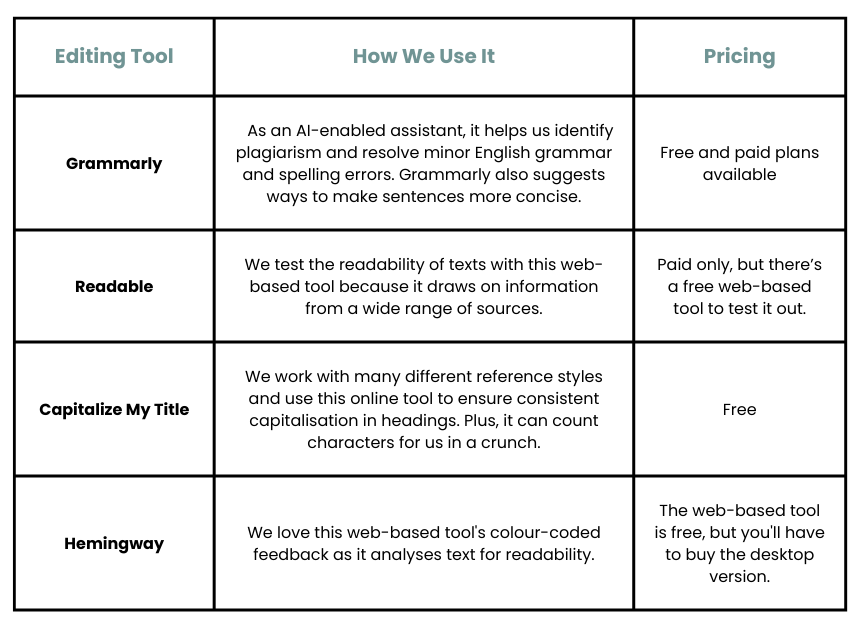Our Top 7 Best Editing Practices to Polish Any Content

Editing means you’re making a piece of writing better. When it comes to core editing practices—consistency, clarity, accuracy—they’re all related to effective and smooth communication. That’s the goal of all types of editing.
Much like writing, everyone approaches editing differently. There isn’t one correct way to do it, but there are multiple guidelines and tips that can help. The editing practices in this post are quick to understand, adaptable, and easy to implement.
Table of Contents
1. The Editing Exercise Workout: Take Regular Breaks
Taking breaks is important when it comes to self-editing. After staring at a paragraph for over an hour, it won’t hurt to take a breather. When looking at it with fresh eyes, you might see things differently. Here are some approaches that can help:
- The Pomodoro technique: This technique is useful if you have a short attention span. Think of it as doing an editing exercise workout. You work for 25-minute stretches, with 5-minute breaks in between each stretch. After 4 repetitions of this, you take a longer break that lasts about 30 minutes. Then you start again.
- Time blocking: This technique is useful when you’re the type of person whose breaks tend to last longer than scheduled. Time blocking requires you to dedicate a set amount of time to one task. Only once you’ve completed it are you free to move on to the next one. You can plan breaks in between tasks.
Think of it like living in a house. You see the dust on the top shelf of the broom closet. Visitors don't. Taking regular breaks should have you returning to a piece of writing as a visitor, not the writer.
2. Proofreading Perfection: Read the Text Out Loud
Reading aloud is great for effective proofreading and copy editing. It allows you to examine words in a different way. It’s useful when editing for clarity since you’ll be able to spot complex sentences and errors that you might not catch otherwise. Here are two easy strategies to try:
- Record yourself: It’s important to consider your pacing while reading aloud. Reading too fast might have you skimming over errors and committing other editing faux pas. Hearing yourself read can help with identifying and correcting common grammar and punctuation mistakes. It’s also great for enhancing the clarity of a piece and improving dialogue.
- Read to others: An audience will be able to hear if something isn’t clear or logical. Based on their reactions, you can identify how effective the plot is and how likeable your characters are. It can also improve the flow of your writing.
Jane Austen used to read her books aloud to her family. In an opinion piece, Dr Ruth Wilson says, “[Austen] possibly adjusted spaces for pausing, tone of voice and emphasis in her writing.” Now, you may have your own opinions of Austen’s writing skills, but her books are still selling a couple of centuries after her death.
3. Organised Efforts: Focus on One Thing at a Time
Multitasking is the enemy of productivity. Many people would be surprised by just how much of a toll it takes on their work. Studies have shown that multitasking can lead to far more oversights. When it comes to the editing workflow, trying to do everything at once isn’t one of the best editing practices to follow. You can combat multitasking by:
- Prioritising: People tend to multitask when they have a lot to do but don’t know where to start. To help you with this, sit down and make a list. Identify and complete the most pressing tasks first since they’ll be the ones nagging at you. Then, work your way down the list until you’ve crossed off everything.
- Organising: Multitasking can also come from being disorganised, which leads to procrastination. You can enhance your focus and catch more errors by keeping your work environment neat and distraction-free, planning ahead, and breaking tasks down into smaller, less intimidating pieces.
If you look at the larger picture, you might get intimidated or deterred. That's when you'll likely start trying to do everything at once. The key is to do it tree by tree. To paraphrase Stephen King: the forest will come, one tree at a time.
4. Appealing to Your Audience: Keep the Reader in Mind
When you edit a piece of writing, remember you’re doing it for a specific group of readers. They’ll arrive with expectations. Horror readers don’t want a thesis on the neurological effects of fear, and veterinary professors don’t want a doctoral thesis that’s a YA rewriting of George Orwell’s Animal Farm. Understand what an audience wants by:
- Researching the genre: Doing your homework while editing is just as important as doing research when writing. Read material that’s related to what you’re editing, learn about the clichés and tropes found within the genre, and check recent bestseller lists.
- Familiarising yourself with the audience: A great way to do this would be to go online and check reviews for the type of material you’re editing. What are people saying about the sort of project you’re working on? What were their thoughts on similar projects? Were their expectations met?
Think about how you’d approach a romance novel versus editing a magazine article on current affairs. They’re very different from each other—both in content and purpose—and should be approached that way. Romance novel writing is often character-driven and descriptive, while the magazine article would need to be concise and direct.
5. On the Chopping Block: Remove the Fluff
Have you ever heard someone refer to writing as “fluffy” or “full of fluff”? “Fluff” refers to padding and unnecessary information. It usually means that the writing isn’t concise enough. Often, this will affect the pacing of a piece. You can remove fluff by:
- Limiting adverbs and adjectives: Many people think that adverbs and adjectives are the enemy of good writing, but it’s overusing them that breaks the “show, don’t tell” rule. If your sentences rely heavily on adverbs and adjectives, consider rewriting them to enhance their readability and clarity.
- Cutting redundancy: Every sentence needs to serve the writing in a purposeful way, either through characterisation or moving the plot forward. Keep your information relevant, though. There’s no point in describing emotional health themes if they aren’t crucial to the story.
This doesn’t just relate to editing fiction. You can apply it to all types of writing. For instance, have you ever searched for a recipe online, clicked on a link, but had to scroll to the bottom to find the recipe? The recipe was relevant; the rest wasn’t.
6. Ditch the Differences: Double-Check for Consistency
Consistency has to do with readability. Writing should feel uniform and coherent, not choppy and hodgepodge. This is relevant to all aspects of writing, including formatting, spelling, grammar, and terminology. You can ensure consistency by:
- Creating a writing guide: This is a document that details the linguistic conventions of a project or company. While you’re reviewing something, it’s really useful to have a writing and editing style guide that outlines exactly what type of language you should be using.
- Planning: Whether you’re a planner or a pantser, making use of an outline (no matter how rough) can work wonders to improve consistency. Even if it’s just in your head, knowing where a scene or chapter is going will be invaluable. Reading the previous day’s writing before moving forward can help with this.
Staying consistent is an important part of a writing's merit. If you sign up for a newsletter from an author's website but receive a document containing an abundance of spelling mistakes, you'll notice. If you read a thesis, but it suddenly starts quoting from the Necronomicon, you'll also notice.
7. The Online Edge: Use Proofreading and Editing Tools
Online editing tools can help you learn and self-edit more efficiently. There are quite a few to choose from, but it all comes down to individual preference and budget:
Editing Tool
How We Use It
Pricing

Editing with AI and digital tools is by no means foolproof. They don’t take artistic licence into account and don’t always understand context. They can, however, help you develop your editing skills to present a tidier manuscript to professional editors.
Build Up a Tailored Toolkit of Editing Practices
The whole principle of editing comes down to making communication smoother. There are many ways to grow as a writer and editor, like getting feedback from friends or volunteering as a first reader at an online magazine. The key is to continually learn and improve the way you work.
Much like writing, the editing process differs from person to person. Use the above editing and proofreading best practices to help you develop your own editing techniques. Adapt the principles, and find what works for you. Who knows, you may even want to start a new job as an editor.

Blue Leaf Team
The Blue Leaf Editing team has over 10 years of combined editing, publishing, and book industry experience. We’re passionate about content and storytelling, and sharing our knowledge with others.
info@blueleafediting.com